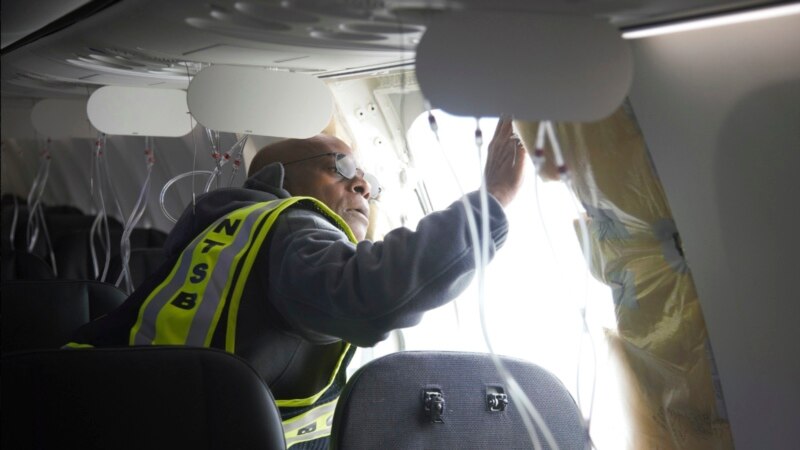
The U.S. National Transportation Safety Board said late on Sunday the “key missing component” from the Boeing 737 MAX 9 jet involved in an Alaska Airlines emergency landing had been recovered from the backyard of a suburban home.
The plug door tore off the left side of an Alaska Airlines jet on Friday following takeoff from Portland, Oregon, en route to Ontario, California, depressurizing the plane and forcing pilots to turn back and land safely with all 171 passengers and six crew on board.
The Federal Aviation Administration on Saturday ordered the temporary grounding of 171 Boeing MAX 9 jets installed with the same panel, which weighs about 27 kg and covers an optional exit door mainly used by low-cost airlines.
The missing plug door was recovered on Sunday by a Portland school teacher identified only as “Bob” in the Cedar Hills neighborhood who found it in his backyard, NTSB Chair Jennifer Homendy said, saying she was “very relieved” it had been found.
She had earlier told reporters the aircraft part was a “key missing component” to determine why the accident occurred.
“Our structures team will want to look at everything on the door – all of the components on the door to see to look at witness marks, to look at any paint transfer, what shape the door was in when found. That can tell them a lot about what occurred,” she said.
The force from the loss of the plug door was strong enough to blow open the cockpit door during flight, said Homendy, who said it must have been a “terrifying event” to experience.
“They heard a bang,” Homendy said of the pilots, who were interviewed by investigators.
A quick reference laminated checklist flew out the door, while the first officer lost her headset, she said. “Communication was a serious issue… It was described as chaos.”
Homendy said the cockpit voice recorder did not capture any data because it had been overwritten and again called on regulators to mandate retrofitting existing planes with recorders that capture 25 hours of data, up from the two hours required at present.
Earlier pressurization issues
Homendy said the auto pressurization fail light illuminated on the same Alaska Airlines aircraft on Dec. 7, Jan. 3 and Jan. 4, but it was unclear if there was any connection between those incidents and the accident.
Alaska Airlines made a decision after the warnings to restrict the aircraft from making long flights over water to Hawaii so that it could return quickly to an airport if needed, Homendy said.
The Seattle-based carrier said earlier in response to questions about the warning lights that aircraft pressurization system write-ups were typical in commercial aviation operations with large planes.
The airline said, “in every case, the write up was fully evaluated and resolved per approved maintenance procedures and in full compliance with all applicable FAA regulations.”
Alaska Airlines added it has an internal policy to restrict aircraft with multiple maintenance write-ups on some systems from long flights over water that was not required by the FAA.
Planes grounded
The FAA said on Sunday the affected fleet of Boeing MAX 9 planes, including those operated by other carriers such as United Airlines, would remain grounded until the regulator was satisfied they were safe.
The FAA initially said on Saturday the required inspections would take four to eight hours, leading many in the industry to assume the planes could very quickly return to service.
But criteria for the checks have yet to be agreed between the FAA and Boeing, meaning airlines have yet to receive detailed instructions, people familiar with the matter said.
The FAA must approve Boeing’s inspection criteria before the checks can be completed and planes can resume flights. Alaska Airlines said late on Sunday it had still not received instructions from Boeing.
Alaska Airlines canceled 170 flights on Sunday and a further 60 on Monday and said travel disruptions from the grounding were expected to last through at least midweek. United, which has grounded its 79 MAX 9s, canceled 230 flights on Sunday, or 8% of scheduled departures.
The accident has put Boeing back under scrutiny as it awaits certification of its smaller MAX 7 as well as the larger MAX 10, which is needed to compete with a key Airbus model.
In 2019, global authorities subjected all MAX planes to a wider grounding that lasted 20 months after crashes in Ethiopia and Indonesia linked to poorly designed cockpit software killed a total of 346 people.
